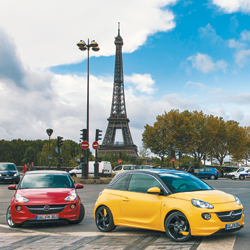|
sizzle awards

Photos: Kertis Creative
In the Mood: How GE Appliances Redesigned its Engagement Strategy
Faced with the challenge of targeting an entirely new attendee demographic, GE Appliances develops an engaging in-booth activity that stirs up 121 million social-media impressions and increases leads by nearly 20 percent. By Brian Dukerschein
Early in 2018, GE Appliances (GEA), a Haier Group Corp. company, underwent something of a redesign itself, one that it hoped would increase its slice of the roughly $500 billion global home-appliance pie. After an uninterrupted history of marketing its multiple lines of home appliances, e.g., Monogram and Profile, as subheads (or "series," to use the preferred corporate parlance) under the GE banner, GEA announced it was reinventing itself as a "house of brands." Company leadership felt that by strengthening the identities of its product series and turning them into standalone brands, GEA would be better able to target diverse groups of consumers and grow its business. For example, top-of-the-line Monogram kitchenwares would be positioned as the ideal choice for gourmands, while the sleek Profile collection would be marketed to those wanting a modern look on a more modest budget. Coinciding with GEA's internal overhaul was the launch of its Café brand, a line of kitchen appliances encompassing cooktops, wall ovens, refrigerators, microwaves, and more. What sets Café pieces apart from many competitors is that their finishes can be customized to complement a range of kitchen styles. A Café dishwasher, for instance, may be clad in a customer's choice of matte white, matte black, or stainless steel and accented with a black, bronze, copper, or stainless-steel handle. Positioned in GEA's brand hierarchy as a mass-premium label, i.e., not as professional-grade as Monogram but a step above the Profile line, Café targets a previously untapped market: style-conscious consumers who value design as much as efficacy. Between the corporate reorganizing and the debut of the Café line, GEA marketers had a lot on their plate going into the 2019 Kitchen and Bath Industry Show (KBIS), one of the most important expos on their exhibiting calendar. In regard to promoting Café, marketing experience and design manager Matt Jones explains that the challenge on his front burner boiled down to one simple issue. "Historically, GE Appliances' messaging has centered around performance and engineering, so focusing on aesthetics is a new direction," he says. "A product demo typically involved cooking, cooling, or washing, but now we had to find a new way to engage with our audience if we wanted to highlight the Café line's primary differentiator." 
To get participants' creative juices flowing, GE Appliances displayed the mood boards created by the nine design influencers in the Café Collective.
To the Drawing BoardThe audience Jones and his team were targeting at KBIS comprised certified kitchen and bath designers, a select group of professionals specially trained in the many nuances of composing these multifaceted spaces and whose interests are far different from the home builders that make up the majority of the show's demographic. "Design and aesthetics are the primary drivers for kitchen and bath designers," says Café brand manager Courtnay Greenberg. "They want to touch and feel the materials, explore the creative applications of the products, and find emerging trends that will wow their clients." GEA developed a robust marketing strategy for the brand launch, and the thought was that elements of the plan should be incorporated into the KBIS exhibit. So the team invited Steve Deckel, design director of Deckel & Moneypenny Exhibits, GEA's exhibit house for more than 30 years, to the corporate office and introduced him to "Amanda," the persona created to embody the ideal Café consumer. "During the initial meeting, I was briefed on who Amanda is and what is important to her, namely design and entertaining," Deckel says. "The Café team's initial request was for us to fabricate a large communal table for a dinner-party scene, which they felt would appeal to kitchen designers and convey the spirit behind the brand." As ideas regarding place settings and atmosphere were tossed around, Deckel couldn't help but notice a table on the other side of the conference room that was piled high with swatches and design materials. "I asked what was going on there, and was told it was for the Café Collective social-media campaign for the overall brand launch," Deckel says. "A handful of kitchen- and interior-design influencers had agreed to include new Café products in upcoming projects, document their processes on mood boards, and share their creations on Instagram." The visual and creative elements of the campaign – and the fact that it included mood boards, the collage-like assemblages of swatches, images, and objects frequently used by designers to convey their artistic visions to clients – resonated with Deckel and compelled him to pitch a different approach. "I immediately told the GEA team that we should replace the communal table with a mood-board space and invite designers at KBIS to create their own collages and share them on social media." The Café team applauded the idea and added a small but important tweak that turned the activation into more of a true product demonstration aligned with the nascent brand's overall message. "We are trying to change the dialogue when it comes to kitchen design," says Sarah Currie, an industrial designer at GEA. "Appliances are often treated as an afterthought when it comes to designing a kitchen, so we wanted to pose the challenge of using them as the main source of inspiration. Participants would be asked to imagine their dream kitchens, and as the first step in creating their mood boards, they'd select their appliance and finish. Everything else, such as paint, countertops, and cabinetry, would revolve around the custom Café element." While Deckel & Moneypenny got to work turning the mood-board idea into reality, GEA focused on turning up the marketing heat. Starting four months before the February opening of KBIS, a series of emails sent to preregistered attendees introduced the Café brand and invited recipients to the booth. A physical mailer and outreach to the press soon followed, as well as banner ads on the show's website and app. Meanwhile, the Café Collective campaign went live, as the nine influencers shared their carefully composed mood boards on Instagram. In effect, the posts served as both a promotional tool for the newly launched brand and a hint as to what targeted KBIS attendees, many of whom likely followed at least one of the tastemakers, could expect in the Café portion of GEA's exhibit. Feeling Moody Their curiosity piqued by the steady stream of pre-show teasers, KBIS showgoers made their way to GEA's brand-new exhibit. In keeping with its desire to position its product series as distinct brands, the company divided its 110-by-130-foot booth into four discrete zones, each with a unique aesthetic befitting the Monogram, Hotpoint, GE/Profile, and Café lines showcased inside. The 57-by-70-foot Café space was a chic oasis with four showroom-like kitchens in each corner acting as vignettes for the brand's versatility. One kitchen, for example, featured matte-black Café appliances complemented by royal-blue cabinets and a gold metallic backsplash. Another head-turning display offered up green cabinetry, ivory marble accents, and white appliances augmented with brushed-copper hardware. 
Room and Board
Thanks to a battery of pre-show training, GEA staffers were primed to engage attendees and encourage participation in the mood-board demo. While certified kitchen and bath designers were the target audience, all booth visitors were welcome to take part. Staffers escorted interested attendees to the demo area, which was positioned on the interior side of an aisle-adjacent wall and consisted of merely three bistro-height tables with iron legs, marble tops, and a mix of built-in shelves and drawers.Upon completing their mood boards, participants were encouraged to share their creations on social media using their own smartphones or an iPad that uploaded images to GE Appliances' show-specific microsite. After explaining how Café appliances can be tailored to suit practically any kitchen style, staffers turned participants' attention to the nearby wall, where Deckel had mounted the nine Instagram influencers' mood boards. GEA reps elaborated on how the tastemakers began composing their collages by selecting a Café appliance with their preferred finish and hardware options, then chose elements, e.g., paint chips, drawer pulls, countertops, cutlery, etc., to round out their visions. Now it was attendees' turn to do the same, starting by perusing the gamut of Café's offerings. Moving to the tables, staffers presented up to six participants at a time with 22-inch-square laminate mood boards. Once they selected a roughly 3-by-3-inch image of a Café appliance with their favored finish and hardware, attendees were free to comb through a soup-to-nuts library of swatches; paint, flooring, and countertop samples; textiles; hardware; and other ephemera. The thousands of pieces of inspirational fodder, collected by Deckel & Moneypenny and GEA, were organized in clear storage bins procured from The Container Store and housed on the shelves beneath the workstations. Eager to flex their creative muscles, professional and amateur designers alike scoured the bins as they hunted for just the right shade of paint, the perfect floor tile, and the ideal swatch of fabric, and then set their selections off to the side. Currie and another GEA industrial designer assisted attendees in their endeavors, a staffing choice that came with two additional benefits. "When the participants found out they were doing this activity with the designers behind the appliances, they became even more engaged, which led to in-depth conversations," Deckel says. "As a result, GEA walked away with a ton of product feedback." After they pulled their preferred items from the library, designers added them to their mood boards by simply laying them across the white surfaces in thoughtful, layered compositions. When they felt their boards accurately depicted their artistic visions, participants received branded note cards on which to write their names and social-media handles. Staffers then handed them an iPad loaded with a proprietary app. Once attendees snapped a pic of their creations, the photos were uploaded to GEA's show-specific microsite. The app also prompted users to share their images on social media, and, of course, attendees were free to photograph and share images on their own mobile devices. Before leaving the demo area and exploring the rest of the exhibit, some thoughtful participants disassembled their mood boards and returned their swatches to the bins. If attendees were too eager to move on, staffers offered to handle the cleanup duties. But regardless of how their engagements ended, showgoers walked away with a clear understanding of how Café appliances can be tailored to suit the kitchen of anyone's dreams. Better by Design By immersing attendees in a hands-on demo of the Café line's design-friendly versatility, GEA marketers hoped to convey the message that their new brand was the antithesis of a dull-as-dishwater collection of kitchen basics. And judging by the exhibit's performance at KBIS, the creative product demo proved to be anything but an underbaked tactic to do just that. GEA set a goal of convincing 72 booth visitors to complete a mood board, but the excitement of having total creative license compelled 123 attendees to create a collage, exceeding the marketers' expectations by 71 percent. Other praise-worthy metrics include the activation's effect on dwell time (the aim for an average of 20 minutes was easily bested), lead counts (up 19 percent compared to KBIS 2018 versus a goal of 5 percent), and media visits (an astounding 150-percent uptick compared to 2018). Social media also couldn't get enough of GEA's Instagram-ready demo. Hoping to score 90 mentions and 111 million impressions on social media, marketers ultimately netted 101 Café-brand mentions and 121 million impressions – 105 million more than the Monogram, GE, and Profile brands combined. Finally, GEA took home its first-ever Best of Show Award in the Large Exhibit category, thanks in no small part to Café's performance. What impressed Sizzle Awards judges the most, however, was the demo's high level of interaction. "This was truly experiential," said one judge. "They created an activation that merged online and offline engagements, demonstrated in a concrete way how these appliances can be personalized, and allowed attendees to be creative and express their own unique tastes." So while there are many cooks in the home-appliance-industry kitchen, it seems GEA proved that its style-centric Café brand can absolutely take the heat. E
|
|
|
||||||||||||||||||||||||||||
|
|
||||||||||||||||||||||||||||
|
TOPICS Measurement & Budgeting Planning & Execution Marketing & Promotion Events & Venues Personal & Career Exhibits & Experiences International Exhibiting Resources for Rookies Research & Resources |
MAGAZINE Subscribe Today! Renew Subscription Update Address Digital Downloads Newsletters Advertise |
FIND-IT Exhibit & Display Producers Products & Services Supplier to Supplier All Companies Compare Get Listed |
EXHIBITORLIVE Sessions Certification Exhibit Hall Exhibit at the Show Registration |
ETRAK Sessions Certification F.A.Q. Registration |
EDUCATION WEEK Overview Sessions Hotel Registration |
CERTIFICATION The Program Steps to Certification Faculty and Staff Enroll in CTSM Submit Quiz Answers My CTSM |
AWARDS Sizzle Awards Exhibit Design Awards Portable/Modular Awards Corporate Event Awards Centers of Excellence |
NEWS Associations/Press Awards Company News International New Products People Shows & Events Venues & Destinations EXHIBITOR News |
||||||||||||||||||||
|
||||||||||||||||||||||||||||






